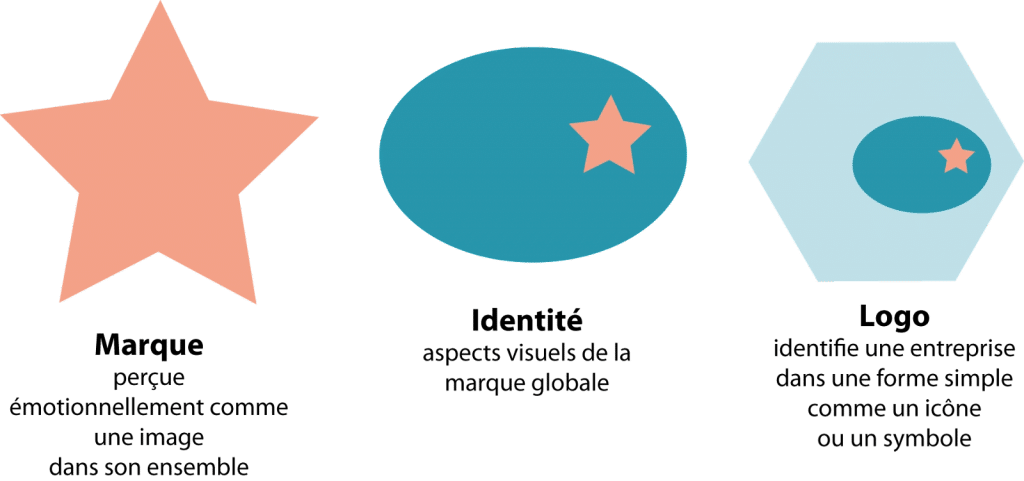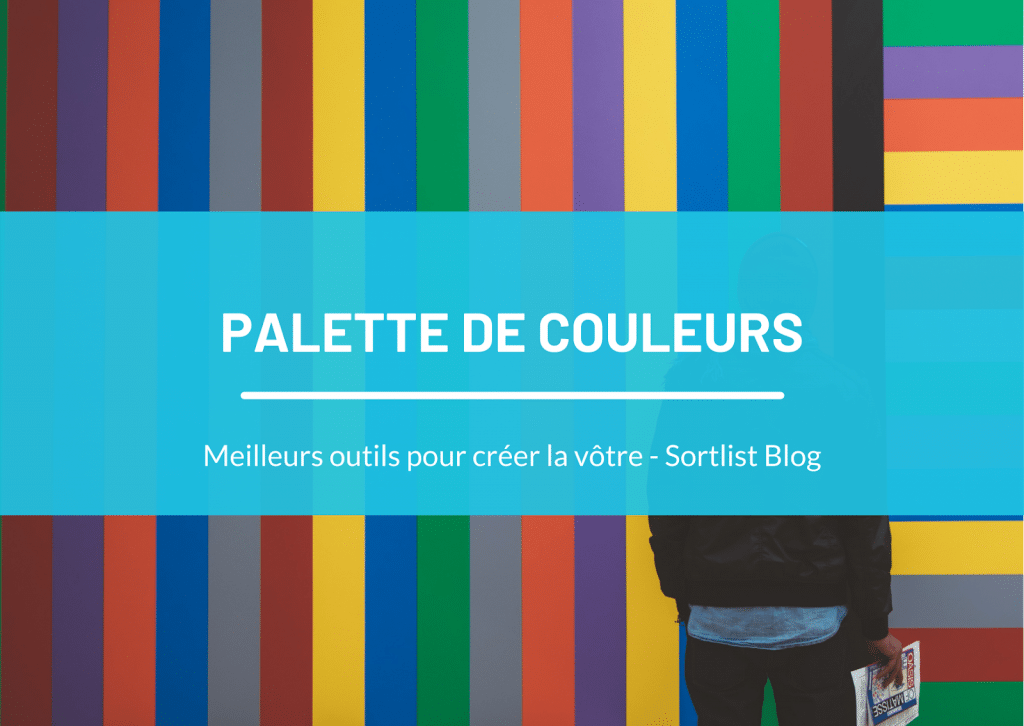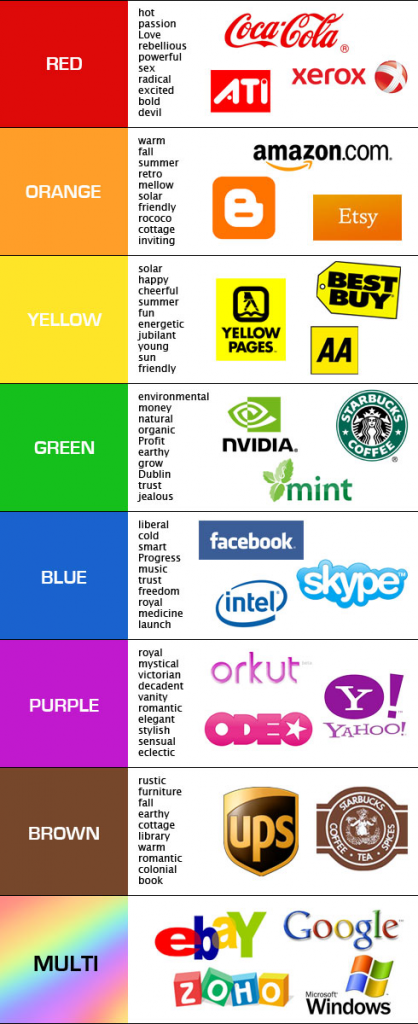According to the figures, a consistent brand presentation increases company revenue by 23% on average.
A statistic that perfectly illustrates how a carefully presented brand identity can boost a company’s sales.
But concretely:
- What is a brand identity?
- How can a brand identity influence company revenue?
- How to strengthen brand identity to benefit from its advantages?
Find the answers to these questions to take advantage of your brand identity and increase your turnover.
Table of Contents
ToggleChapter 1: What does a brand identity really mean?
In this first chapter, we will cover some basic notions allowing you to better understand the concept of brand identity.
1.1. What is a brand identity?
To keep it simple, we will refer to this short definition proposed by 99designs :
“Brand identity is the collection of all the elements that a company creates to give the right image to its consumer.”’
In other words, we can simply say that brand identity is just the face of a company to its customers. These are all the visual elements that immediately draw the public’s attention to a brand.

Source : Web marketing
For example, we encounter elements on a daily basis that make us think of a brand, notably the logo, the slogan or simply its name.
However, it is not enough for a brand to have these elements to succeed in its niche. The brand must first build an impactful brand identity that reaches more audiences.
1.2. The main elements of a brand identity
A brand’s identity is a bit like the company’s showcase and must be composed of at least certain important elements such as:
1.2.1. The brand logo
Your logo is the first visual element that represents your brand. This is the symbol specific to your company by which your potential and existing customers will be able to identify you.

Source : bastacommunication
This is why it must be simple, meaningful and easily memorable. To build a logo, businesses can opt for a shape, a font, or a combination of both.
Let us also remember that it is not uncommon to notice that certain companies have two logos alone. Don’t worry, it’s not for fun.????
Most of the time, the second logo represents a sub-brand that the company wants to present in a different way than the first.
Furthermore, the logo acquires its notoriety over time thanks to the quality of service that the company provides, its ability to establish itself in its niche and its impact on its community.
1.2.2. The typography of the brand
Typography refers to the art and technique of arranging characters to make writing readable and attractive.

Source : atelierssud
It has a significant impact on how people perceive your brand identity, your brand and the message it conveys.
A study conducted by MIT psychologist Kevin Larson relied on two different print layouts, one designed with bad typography and another designed with good typography.
The result of the study showed that:
“The document with a better font choice took less time to read and led to increased cognitive focus and a stronger sense of clarity.”
Using multiple fonts can really help elevate and refine a brand’s identity, but choices need to be carefully considered.
A simple way to start mixing fonts is to use a sans serif and a serif font, as there is a great contrast between the two styles.
Unless you’re an experienced typographer, it’s a good rule of thumb to stop at two fonts. Using a lot of fonts can make your brand image confusing and clarity will be negatively impacted.
1.2.3. The color palette
Although it is not advisable to use multiple fonts to clutter your design, you can become very popular with the combination of multiple colors that work well together.

Source : sortlist
A color palette that represents your brand’s personality resonates well with your potential customers.
A good color combination evokes different emotions in your readers when they come into contact with your profiles.
Colors are likely to impact a man’s psychology and they can even encourage us to take action.
For these reasons, color is an essential part of any branding strategy and a practical way to differentiate your business.
Some brands use a ton of colors while others only use a few, but it’s important to establish a color palette that can work well with your entire business.
1.2.4. The reason
Using a pattern or texture as a design element is another way for a brand to stand out from the competition, communicate its personality and maintain its value.

Source : pinimg
Patterns can be repeated or random, typographic, abstract, conversational or iconographic.
Templates often develop from an organization’s logo, but they can also be designed from scratch.
When applied correctly, a pattern can be an extremely effective branding asset.
1.2.5. Photography
We process images faster than words and everyone loves good photography, good photography sells easier.
Choosing a style of photography and applying it consistently throughout your business is a good way to solidify your identity with customers.

Source : b2b-infos
The style you choose can reflect your company’s personality or capabilities.
It’s very important to use high quality images, but if you can’t find the right ones, it’s worth briefing a photographer.
1.2.6. Illustrations
Illustration has really gained popularity, especially in the world of digital marketing these days.
Many tech giants are currently using illustration and it definitely helps them stand out as it allows the company to create something unique that suits their brand.
Illustrations do not only take care of the visual side of a brand. They also offer good usability for a better user experience.
Additionally, illustrations in the form of information graphics are a great way to communicate ideas, sometimes even better than words.
1.2.7. The animations
Using animations as part of a brand identity can bring your communication to life and excitement.
Animation is a great way to capture user attention and engage your audience.
It can drive purchases, positively reinforce customers, and improve the overall experience a customer receives.
Chapter 2: How Does Brand Identity Impact Your Business Growth?
As an entrepreneur, whatever your niche, it is important that you ensure the identity of your brand for the smooth running of your activities.
Here is a list of some benefits to help you understand the importance of brand identity:
2.1. A brand identity makes a business memorable
While many consumers take the time to research and compare options before purchasing a product or service, others simply choose what they already know.
For this reason, big brands like Coca-Cola or Apple invest billions of dollars in advertising every year.

Source : i.f1g
The aim of these advertising campaigns is to capitalize on the concept of brand recognition.
When you circulate a strong brand identity with good, standardized font, color, and logo choices that represent your business, your audience will be more likely to remember your brand.
2.2. Brand identity gives your business a personality
With the pace of change in modern businesses, building a personal identity for your organization is essential.
Personality allows your business to offer consumers something that didn’t exist at all, which may lead them to consider you an expert or a reference person in your field.
Whatever your brand identity, building it will help you stand out in the marketplace.

The way the company thinks and behaves will be brought to the forefront, and delivering a consistent and strong brand message to people will help them remember you over other brands.
2.3. Good positioning on the market
One of the first things that any entrepreneur would like to achieve is to position their business well in the market.
This can be difficult if you have a lot of competitors, but with a brand identity, it is sure to set you apart from the competition with a good reputation.

Source : synapse
There are several factors to consider to determine where you want to place yourself among all the companies that offer the same services and products as you.
For example, by clearly showing how your business is different from others, your audience will know what to expect every time they hear or see your brand name.
This will make consumers trust and talk about your brand naturally, which is a great way to increase sales and market share.
3.4. Making your new business appear bigger in the market
If done correctly, creating a brand identity can begin to make your brand appear bigger and more visible in the market.
It’s not about fooling people into thinking your company is a huge organization when in fact you’re a start-up.
But a brand identity establishes awareness of your brand and helps it stand out.

If your designs appear professional and unique, your company’s presence could be considered more established in the market.
Branding also helps give your clients the impression that even though you are a small business, you can easily take on larger projects and present professional work.
Quality branding will also present your business as one that can help your customers succeed
3.5. Networking
Building a network of potential partners and consumers is essential to increasing your business’s sales.
You can do this by using social media to create a targeted network of people who want to see your product or service.

Building relationships is important for businesses of all sizes and is the best way to stand out from your competitors.
3.6. Makes the business more profitable
Science Direct has published a research paper on the impact of brand identity. The paper states that having a brand identity could lead to great financial rewards.
This is especially true when branding is perceived and a company’s goals for its brand identity match or closely align.
When this happens, the company’s brand identity policies become more streamlined.
Brand identities designed using guidelines, then tested, measured and improved, generate economic gains.
3.7. Increases brand value
Brand equity is the additional value a company receives by being a recognized brand.

Source : was s1
High brand equity is always a positive thing. For example, if a consumer recognizes your brand by its logo and shortly thereafter purchases a product or service from your company, you have increased your brand equity.
Your brand equity continues to grow if a consumer recommends someone to your business who makes a purchase.
We know that when consumers choose one brand over another, it is because of superior product quality, service and customer experience.
However, it is identifiable branding that makes your business easy to remember in a consumer’s mind.
When they’re ready to buy, they think of your business first. Good branding keeps your business at the forefront of their minds and this increases your brand equity.
When businesses ignore the branding process, they lose sales because the emotional connection between their audience and their business is lost.
In the minds of many consumers, generic brands are of inferior quality. Do you want your brand to be perceived like this? ????
Obviously not, however this perception is so strong that some consumers do not even consider generic brands when making a purchasing decision.
If your business doesn’t have a consistent brand identity across all your marketing materials, it may be unrecognizable and perceived as generic by your prospects.
Chapter 3: How Great Design Can Help Your Brand Sell?
Graphic design can play an important role in your prospects’ decision. In this chapter, we’ll discuss how design helps your business sell and the competitive advantages it gives you.
3.1. Promote company values
Professional branding immediately gives people the impression that you are an established, confident and trustworthy company.

Source : contact-companies
Of course, if you choose not to invest in your brand design, the opposite may be true.
Would you be able to trust a construction company to do a high standard of work if their logo was clipart and their website looked like it was designed by someone who just read ‘How to Build a Website for Dummies’ ‘.
Probably not much. A well-designed logo and website can make the difference between a sale and a walk-through.
3.2. Demonstrate the usefulness of your brand
Having a strong visual brand creates a feeling of unity and cohesion.
By maintaining consistent and clear branding across all marketing channels, for example, community events and your website, customers can instantly and easily recognize your brand.
Conversely, not having a consistent visual brand design can lead to confusion.
You may have business cards, vehicle decals, and street signs, but if they don’t all have the same branding or logo, customers will have a hard time finding you.
3.3. Increase the financial growth of your business
Identity design may be the reason someone will pay thousands of dollars more for a Lexus than a Toyota.
They are both made by the same company. However, the concept of identity is different.
These two vehicles are essentially the same product, except for a few additional options and certainly a few additional accessories.
Identity design creates superior perceived quality that has been repeatedly shown to positively influence consumer usage patterns, frequency and volume.
Consumers naturally tend to select brands that they perceive as higher quality brands.

Source : macadam
Brand identity is also linked to consumers’ repeat purchase behavior, which improves brand loyalty and revenue.
Consumers generally tend to continue purchasing brands that reward them with a higher quality experience. Brand identity is the way to create that experience.
When thinking about a strategy to increase your revenue or when bringing a new product to market, don’t forget to consider the benefits of a brand identity.
This will serve to connect your brand with consumers on a deeper, emotional level.
You can then use this to form a strong community that supports your brand through thick and thin. It’s like free marketing.
3.4. Perception and pride
One of the main benefits of a strong brand identity is the pride felt by employees and customers who can identify with the brand.
Employees and consumers should have a sense of pride in representing and connecting with a brand.
It all starts with the right identity design. This pride is reflected in the visibility of the brand.

Most consumers, employees and customers want to be associated with highly visible and well-defined brands.
So, the “look and feel” of your identity can play a major role in the decision-making process.
The right identity design can generate the right look and feel to appeal to the targeted businesses you want to partner with.
The right identity and branding system can position your business in the right way to work with larger organizations.
Chapter 4: How to create a brand identity that sells?
For the good of your business, it is not enough to have a brand identity, but a brand identity that sells.
Here are some tips to achieve this:
4.1. Know your foundation
Just as you can also agree with me that a house must be built on a solid foundation, you must also note that your brand identity must also rest on cornerstones.
To lay a good foundation, here are some questions you should ask yourself:
- Who are you ?
- What is your personality?
- What do you offer?
- How do you talk about what you do?
If you don’t have this foundation to build on, you can’t design a visual identity that properly tells your brand’s story.
Before continuing, make sure you know your:
Brand heart: It is an articulation of the core principles of your brand, that is, your purpose, vision, mission and values.

Source : lecoindesentrepreneurs
The essence of the brand: It’s about your voice, your tone and your personality.
Messaging: Know your tagline, value proposition, and messaging pillars to ensure your visual identity communicates the right story.
Additionally, you need to know why you are going through this process. If you’re starting from scratch, it’s obvious that you have to do this.
If you’re rebranding, make sure everyone on your team understands the challenges you face with your current identity and what you hope to accomplish with a new one.
As long as you’ve established the core elements of your brand and your team is on the same page, you’re good to go.
4.2. Evaluate your current identity
To ensure your visual output aligns with your brand values, reflects your personality, and communicates your brand story as a whole, you need to have an intimate understanding of your brand.
So, you should start with a brand assessment to understand:
- The current state of your brand identity;
- How could this brand identity be designed or modified to align with your future goals?
By taking a critical look at your brand, you can gain the information you need to build an identity that communicates it accurately.
4.3. Audit your competition
Building a brand identity is all about differentiation. It’s about making your brand visible, relevant and unique.
So, it’s crucial to understand not only who your competitors are, but also how your brand compares in terms of visual presentation.

With a competitive audit, you can compare your brand to each competitor and compare your competitors as a whole, which can uncover surprising insights.
For example, based on a global observation of the competition, brands tend to use the same colors, but this revealed a great opportunity to differentiate themselves.
Consider Netflix and YouTube’s use of the color red.
In 2011, the video platform Twitch made a splash with its all-purple branding at a time when its competitors were using greens and reds. Color instantly became their trademark.
Scoring these types of opportunities is why a competitive audit can be invaluable.
To do this, use a competitor brand audit template to evaluate your main competitors.
As you move forward in the process, pay close attention to how your competitors present themselves in terms of common visual elements, trends, industry-specific visual themes, brand personalities, etc. .
4.4. Refine a visual direction
Now that you’ve taken a critical look at your current identity and that of your competitors, you’ll have more ideas for aligning your team with the direction you want to go.
Design can be incredibly subjective, but colors that convey a strong feeling to one person may be perceived entirely differently by others.

Source : Keithslater.com
Even the vocabulary you use to describe your brand can be interpreted differently within your team.
At this point, you’re not yet ready to design, you first need to have important conversations and complete exercises that will help you find a common vision for your brand identity.
- What are the key brand traits that you want to express through your visuals?
- What type of visuals communicate these traits?
- What do you want people to feel when they see your brand?
It’s important to get brand stakeholders in the same room to have these conversations, identify the path forward, and ensure everyone on the team shares the same opinion.
The information you get from these conversations will help you craft the creative brief that designers will use to bring the visuals to life.
4.5. Choose the right business name
Your business name embodies the product or service offered and differentiates you from similar brands in the market.

Source : steveaxentios
It’s often the first impression you leave on your potential customers.
Consider a name that best describes who you are as a business and what you provide.
It should be unique, easy to remember, aligned with your brand personality and have branding available.
Choosing a business name is a common obstacle for new business owners, so you need to know how to go about it.
To get your creative juices flowing, let’s look at some types of business names to choose from:
- Traditional name: Traditional business names clearly describe the product or service being offered. It is functional and leaves very little room for confusion.
A traditional name is suitable for a company that wants to convey a feeling of reliability and seriousness. The benefit of choosing a traditional business name is that it communicates the main purpose of your business.
- Name of invention: If you can’t find the perfect word that best describes your business, you can always invent one.
Made-up names give you plenty of opportunity for creativity, but they’re not the easiest to come up with. You can simply take inspiration from the service you provide like Airbnb.
- Compound noun : You can merge two different words to create a name that uniquely defines your business.
Compound nouns leave room for creativity, while providing some context. The name precisely describes the service it offers, which involves connecting users with their professional network.
- Multi-word name: Two-word business names are a combination of strong keywords or the founder’s name. Many well-known brands have adopted a multi-word business name.
4.6. Design the perfect logo
Your logo is the main visual focal point of your entire brand identity. Consider the message you want to resonate with your audience, while communicating your business message.

Source : Digital synopsis
Whether you hire a designer or design your logo yourself, it should capture the essence of your brand. Keep in mind that it should be simple, timeless, scalable and memorable.
Done right, a logo can attract and hold the attention of your target audience, make a lasting impression, distinguish you from your competitors and foster brand loyalty.
Many business owners spend a lot of time trying to find the best and most original design ever to make their brand stand out.
Instead, focus on establishing patterns through colors, fonts, icons that evoke a certain feeling from your audience.
4.7. Come up with a catchy slogan
After your company name and logo, your slogan is a powerful marketing tool. A good slogan should elicit a response from your target audience.

Source : creads
A tagline captures the unique value your brand offers and helps your audience associate your business with an overall idea.
Maybe your slogan clarifies what you do or expresses an important brand attribute, like Nike’s “Just do it.” Invented in 1988, it is timeless and expresses motivation and strength in just three words.
A tagline is also something you can add later as your business grows.
4.8. Choose your typography
Typography is the big umbrella term to which all fonts belong. Basically, it’s just the way the letters are arranged.
Choosing the right typography in your logo could strengthen your overall brand.
Whether you’re designing a logo for a photography business or business, the font you use can be key to effective brand recognition.
There are five main font families and each of them has its own personality.

Source : ZenBusiness
Once you understand the distinct features of each font, you can choose the one that best represents your business.
- Serif : Gives an air of tradition and formality, which is ideal for organizations in the academic, editorial and financial fields;
- Sans serif : Easy to read and simple. It is a popular choice among start-ups and technology companies;
- Slab serif : Bold and impactful, Slab serif fonts are frequently used by automotive and technology companies;
- Script : Well suited to businesses that want to express elegance and add a personal touch, such as photographers, coaches or any other family brand;
- Decorative: Strong, fun and entertaining, these fonts work great with logos with short business names.
Feel free to play with different font combinations. It’s best to stick to one or two font types.
4.9. Choose a color palette
Color is the most emotional element of your brand identity. Choosing a color palette is an essential way to enhance your identity and add versatility to your designs.

Source : identical
According to Tailorbrabds, colors elicit an emotional response, as blue expresses calm and red passion. Even adjusting the hue can alter the emotion aroused.
Think about how light blue evokes calm, while a darker shade of blue symbolizes confidence. Knowing the emotions that certain colors express can help you select the right ones for your brand.
4.10. Use distinctive graphics and shapes
Brands use visual language with graphics to communicate their distinctive side across a range of mediums like brochures, business cards, as well as other channels like websites, social media, etc.
Shapes can help form a clearer image of your brand with just a few puns. This effective element can be helpful in reinforcing the desired response from your target audience.
If you understand what different shapes are associated with, you will be better able to incorporate them effectively into your design.
4.11. Select Stellar Branding Images
The images you use can grab the attention of people who read you or not.
This is why you need to make sure you find attractive images while remaining true to your brand.
From your website to social media pages, every place you include an image should be quite thoughtful.
To do this, you need to coordinate your images to align the look with the overall image you want to project to the world.

Remember, your brand identity is what sets you apart from your competitors. This is why you have to choose images that look generic or that don’t look like others on the internet.
It is best not to use images taken from an image bank, but rather authentic images of the product or service you are offering.
To achieve this, you have several options to have an authentic image:
- Ask a friend or family member who is more skilled at photography;
- Try your hand at Photoshop;
- Hire a professional photographer even though this option can be expensive;
- Find a photographer who is just starting out and ready to take on projects to build their portfolio at a lower price.
4.12. Create a beautiful website
Think of your website as the home of your business. You invite people over and ask them to stay a while.
Your guests, that is, your target audience, are there to learn more about you, what you do, how you do it. Some guests will stay, others will leave and return.
Most importantly, the goal of your website is to make a good impression and build a lasting relationship with your guests.
It’s important to note that a website is not essential for physical stores, but crucial if you are a digital service or e-commerce.
4.13. Be a Social Media Superstar
Social networks are a fundamental tool for the organic marketing of your business.
Organic marketing attracts customers to your brand using non-paid strategies such as creating content on social media.
The idea is that the more value you offer to your potential customers, the more attracted they will be to you.
A branded presence on social networks like Facebook, Instagram, Pinterest, YouTube and Twitter can help you reach new potential customers and connect with your audience.

With an interesting enough design, you can give your brand an authentic and relevant appearance.
Building a social media presence is by no means something that happens overnight.
Good social media branding is an ongoing process in which you constantly communicate with your audience, responding to their comments and messages, finding new ways to engage with them.
But not all social channels are equal, and you need to carefully consider which one is best for your business.
Instagram is a great way for you to show rather than tell the public about your products and services, your values and your unique voice.
Facebook gives small businesses the opportunity to showcase their products and services to a large audience. Twitter makes it easy to interact with customers and stay relevant.
Each channel has its own algorithm and is difficult to solve. Once you have mastered a social platform and have the opportunity to grow, you can better display your brand identity.
In summary
In short, a brand identity is the physical appearance, the perception that customers have of your brand.
Several elements go into its constitution to make it an identity that allows a company to increase its sales.
Graphic design is also an important aspect that you should not neglect if you really want to increase the results of your activities.
In this article, we have had the time to explain in detail what you need to know in terms of brand identity.


